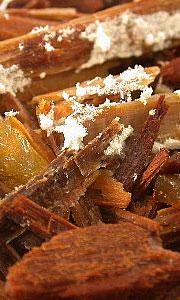 White-rot fungus normally feeds on rotting wood.Credit: Tom Volk
White-rot fungus normally feeds on rotting wood.Credit: Tom VolkA fungus that normally eats wood can also chew up some of the long-lasting plastic resins that clog landfill sites, researchers in the United States have found. This potentially offers an environmentally friendly way to recycle the waste.
Phenolic resins are widely used to glue together plywood and fibreboard, and are commonly found in car mouldings. High pressure and heat are used to link together ring-shaped molecules of phenol with formaldehyde, creating one huge, indestructible molecule.
The resins are popular because they are so durable; but this also makes them difficult to recycle. Unlike polyethylene in drink bottles, the resins are so tough that they cannot be melted and reused. About 2.2 million tonnes of phenolic resin are produced in the United States every year, around 10% of the country's total plastic production.
Some scrap phenolic resins are simply ground up and used in other plastics. Another experimental recycling method uses heat and chemical solvents, but this is expensive and produces dirty by-products.
Adam Gusse and his colleagues at the University of Wisconsin-La Crosse wondered whether white-rot fungi might be able to attack the resins. These fungi are commonly seen on rotting tree stumps and manufacture an array of enzymes able to break down the tough lignin in wood. Lignin has a similar chemical structure to phenolic resins, because it is also made up of ring-like molecules strung together.
Digesting the indigestible
Gusse fed chips of phenolic resin to five different species of white-rot fungus to see whether they could eat it. The team found that one species (Phanerochaete chrysosporium) turned from white to pink after a few days, suggesting that it had broken down the resin into smaller chemical components of the polymer known to be pink.
The team confirmed this by feeding the fungus phenolic resin containing a heavier isotope of carbon, and found that the isotope was incorporated into the fungus after it had feasted on the plastic. To nail the case, they used an electron microscope to show that the resin was pitted with craters after being semi-digested by the fungus. "It's clearly breaking it down," Gusse says.
Gusse suggests that white-rot fungus could even be used to recycle the components of phenolic resins, if a way could be found to recover and re-use the phenol. But the idea is a long way from being commercially viable. The team has not yet shown how efficiently or rapidly the fungus eats the resin, and Gusse suspects that it might take the microbes a few months to finish a meal. This may make it difficult to recover phenol at a competitive price.
ADVERTISEMENT
But the fungi's varied palate could still find a use. Researchers already know that white-rot fungi can digest other plastics such as polystyrene and that it can chew up pollutants such as polychlorinated biphenyls (PCBs). "They puke the enzymes out and eat whatever's around them," Gusse says.
Visit our eatsenduring_plastic.html">newsblog to read and post comments about this story.
